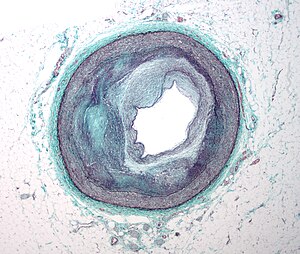 |
| Micrograph of an artery that supplies the heart with significant atherosclerosis and marked luminal narrowing. Tissue has been stained using Masson's trichrome. (Photo credit: Wikipedia) |
Worried about your high bad cholesterol level? WebMD has a Cholesterol Management Center that you can visit to learn more about cholesterol and how you can properly manage your cholesterol level. The website provides tools and resources and information on diet, exercise, tips for avoiding heart disease and natural cholesterol treatment. Links to tools and resources are below. An short extract is also provided below to give you an indication of what the website covers.
Tools & Resources
- A Diet to Lower Cholesterol
- Cholesterol-Busting Exercise
- Tips for Avoiding Heart Disease
- Cholesterol Health Check
- Natural Cholesterol Treatments
High cholesterol is associated with an elevated risk of cardiovascular disease, which can include coronary heart disease, stroke, and peripheral vascular disease. High cholesterol has also been linked to diabetes and high blood pressure. To prevent or manage these conditions, take steps to lower your total cholesterol and LDL cholesterol if they are elevated.
Cholesterol and Coronary Heart Disease
The main risk associated with high cholesterol is coronary heart
disease. Your blood cholesterol level has a lot to do with your chances
of getting heart disease. If cholesterol is too high, it builds up in
the walls of your arteries. Over time, this build-up (called plaque)
causes hardening of the arteries (atherosclerosis).
Atherosclerosis causes arteries to become narrowed, slowing blood flow
to the heart muscle. Reduced blood flow to the heart can result in angina (chest pain) or in a heart attack in cases when a blood vessel is blocked completely.
Cholesterol and Stroke
The main risk associated with high cholesterol is coronary heart
disease. Your blood cholesterol level has a lot to do with your chances
of getting heart disease. If cholesterol is too high, it builds up in
the walls of your arteries. Over time, this build-up (called plaque)
causes hardening of the arteries (atherosclerosis).
Atherosclerosis causes arteries to become narrowed, slowing blood flow
to the heart muscle. Reduced blood flow to the heart can result in angina (chest pain) or in a heart attack in cases when a blood vessel is blocked completely.
Cholesterol and Peripheral Vascular Disease
High cholesterol also has been linked to peripheral vascular
disease, which refers to diseases of blood vessels outside the heart and
brain. In this condition, fatty deposits build up along artery walls
and affect blood circulation, mainly in arteries leading to the legs and
feet.
Cholesterol and Diabetes
Diabetes can upset the balance between HDL and LDLcholesterol levels.
People with diabetes tend to have LDL particles that stick to arteries
and damage blood vessel walls more easily. Glucose (a type of sugar)
attaches to lipoproteins (a cholesterol-protein package that enables
cholesterol to travel through blood). Sugarcoated LDL remains in the
bloodstream longer and may lead to the formation of plaque. People with
diabetes tend to have low HDL and high triglyceride (another kind of
blood fat) levels, both of which boost the risk of heart and artery
disease.
Cholesterol and High Blood Pressure
High blood pressure (also called hypertension) and high
cholesterol also are linked. When the arteries become hardened and
narrowed with cholesterol plaque and calcium (atherosclerosis), the
heart has to strain much harder to pump blood through them. As a result,
blood pressure becomes abnormally high. High blood pressure is also
linked to heart disease.

No comments:
Post a Comment
Thanks for visiting my blog! Please feel free to leave a comment, and do visit often and share the link to the blog!